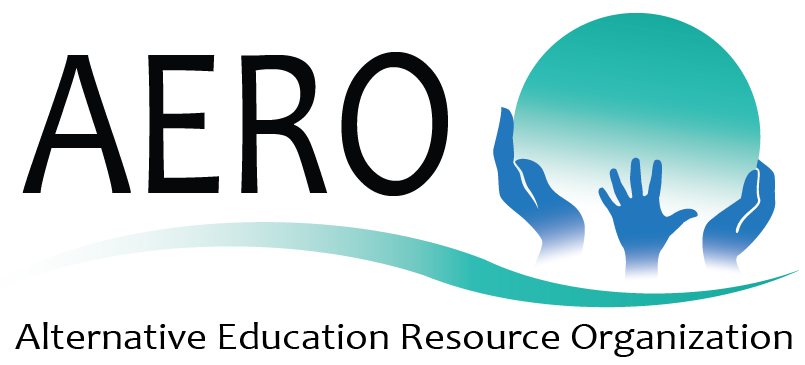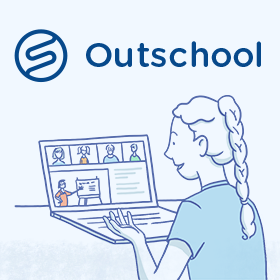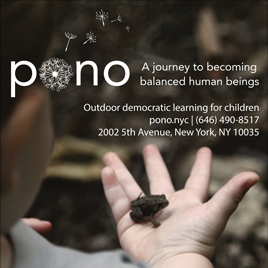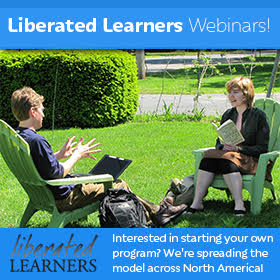[su_document url=”https://www.educationrevolution.org/store/files/2020/05/Job-description-General-Staff.pdf” width=”1600″ height=”1600″]
Brightworks School in San Francisco Is Hiring
[su_document url=”https://www.educationrevolution.org/store/files/2020/04/2020_2021-Middle-School-Collaborator-Job-Posting-Google-Docs.pdf” width=”1600″ height=”1600″]
Discovering Teaching at Outschool
Amongst the AERO Network, there are many members discovering that they can teach as Independent Contractors on the Outschool platform, a marketplace of classes for ages 3-18. Whether Instructors choose to make teaching online a career or are suddenly thrown into needing to financially support their family, Outschool has provided the opportunity to help make a difference in their lives.
Here is a few reasons from the AERO Network of Outschool Instructors:
- “I wanted to leave my career in education and find something where I can stay at home with family.”
- “My husband just got laid off. I am a homeschool mom who has a lot that I can teach.”
- “I just want to make some extra money.”
It was about a 3 week process to get listed with Outschool; some people say it takes longer, but 3 weeks seems to be the minimum. Many people get frustrated by the process and do not complete the steps. One of the tasks involves creating a class for listing and there are several steps to this. Here is an outline of what to expect in creating a class:
Title: Give your course a catchy and descriptive name.
Summary: Write a one sentence summary of the course. Keep in mind that many people are not going to read beyond this summary and never read your course description beyond 2 lines and so the short summary needs to truly encompass what will be taught
Subject: Choose one (arts, coding & tech, English, Health & Wellness, Life Skills, Math, Music, Science & Nature, Social Studies or World Languages)
Course type:
- One-Time – these classes meet by video chat a single time. Discussion may occur by messaging on the classroom page before or after class.
- Multi-Day – These courses meet by video chat over multiple days. Discussion occurs by messaging on the classroom page between meetings.
- Ongoing – Learners subscribe to these classes, which meet by video chat on a weekly schedule. Learners can join or leave at any time.
- Flexible Schedule – These classes occur using asynchronous messaging on the Outschool platform, and do not meet by video chat.
They have to be 4 weeks long or longer in length and each week the Instructor posts a pre-recorded lesson, announcement, assignment, and/or communication between the teacher and parent/learner. Other learning tools can be accessed through our classroom, including quizzes, forums, group activities that are brought back to the classroom, or other interactive software. All materials must be accessible to Outschool staff without a login or password. The description needs to be clear about how that interaction will take place such as through discussion questions, challenge activities, or sharing work.
Course Format:
- Age range: (must be within a 5 year age grouping) from 3 to 18. For example, 3-6 or 10-14.
- Class size: Outschool recommends small classes in general and especially for younger students. For ages 6 and below, up to 6 learners. For ages 6-12, up to 9 learners. For ages 12 and above, up to 12 learners. However, the maximum class size is 18.
- Course Duration: how often and how long will the class meet?
Course Description – Descriptions that are well-written and highly detailed will help set expectations and get enrollments.
- Class experience – How will students learn? How will they interact with the teacher and each other? How is class time structured? What topics will be covered?
- Learning goals (optional) – What will students learn? Be as specific as possible.
- Homework (optional) – What kind of homework is assigned, if any?
- Assessment (optional) – How is learner progress assessed?
The joys of Outschool and how to be highly successful: You set your own prices. Outschool recommends $10-15USD/ hour/ learner. If you charge way less, you may build a following, but you also underestimate your worth and expertise and you will risk burn out. If you charge too much, you may have small, intimate classes and still make money or you will not get enrolment. Describe your expertise and include your social media links. Many charter schools and other companies are always looking for highly qualified people in many subject areas. While they are discouraged from messaging you directly through Outschool, they can find you on social media.
Also, many families looking for Tutors will message you directly through Outschool if their learner was highly engaged in your class and they love your teaching style and personality. You can charge up to $40 USD/ hour / learner on the Outschool platform; you can lead them to your external website…
Some people designate days for one-on-one in their schedule and write in their course descriptions that they are open to one-on-one work. Pricing is based on the price per learner, class size, course duration, and the 30% Outschool service fee. Sometimes this seems like a lot of money to be paying for the service fee. You can run your own courses with the same content off your own websites as long as you charge the same fee as Outschool; in this aspect, many Instructors with unique skill sets schedule on Outschool for their intro type courses, but direct learners elsewhere for their series types and eliminate the 30% fee. Learn about Outschool’s happiness refund policy and refer families to Outschool if they have had tech challenges, are no shows, etc.
Still thinking about diving into teaching on Outschool? Let Jerry or Peter know so they can submit a referral online. Provide them with an email address, the one that you would like to receive Outschool communication from. Each successful referral can end up giving AERO a $200 USD donation.
Not sure what to teach? This week, Outschool received 197 requests for courses. Here are some ideas of what parents and learners are looking for:
- “Phonics to Fluency— Teach basics of reading” for age 5.
- “Film school in two months” for age 11.
- “Baking like macaroons or other delicious desserts” for age 13.
- “Federal Bureau of Investigation” for age 15.
- “Canada, Social studies for grades 5 and 6 particularly relating to British Columbia” for age 11.
- “horse speak 101 how to understand body language of horses” for age 11.
- “Learning the Greek language” for age 9.
- “How To Play Pokemon for Beginners” for age 6.
- “Modern dance or ballet” for age 8.
- “Marine Biology, animals in the deepest parts of the ocean” for age 7.
- “Greater than and less than” for age 6.
- “How to play Yu-Gi-Ho (card game)” for age 10.
- “English prose class 8th chapter 1” for age 14.
- “Flamenco dance (intro.)” for age 7. 15. “Learning Java for kids” for age 10.
By An AERO Member (Better attribution coming soon.)
The Future of Education ACV
After a conversation I had with an AERO member about what I learned from my friendship with John Holt about the future of education, he suggested I write an article about it. Until now it has been very difficult for me to start on this. It is hard to be creative when under the stress of a crisis, a pandemic nightmare from which we are having trouble waking up.
We’ve been advocating the Education Revolution since our founding 31 years ago. Our mission is to make learner-centered education available to people everywhere. With that in mind we have established a website that is #1 on Google for alternative education and for 15 years we have had an online course for people who want to start new learner-centered alternatives. This has led to the establishment of more than 100 new educational alternatives. We see them as seeds, models that can help spread the Education Revolution.
Little could we imagine that practically overnight we would have gone from 3 1/2% of students homeschooling to 96%! Some may say it isn’t homeschooling, but there’s no denying that it is a whole new paradigm for most people.
The whole idea of predicting the future is clearly a nearly impossible process, as recent events have shown. But it is important that we at least guess about the future of education in order to be better prepared to work with it.
As you may know, many years ago John Holt, after trying to reform schools, gave up on them and wrote the book Teach Your Own, introducing the modern movement of homeschooling. I knew John fairly well and had many discussions with him about whether schools could be based truly on the interest of the learner, in a way similar to the concept that he had pioneered, “unschooling.”
One question I asked him back then was whether he was OK with parents who did “school at home” in a very structured way. One example of that was the fundamentalist Christians who told me back then that they couldn’t unschool because of “original sin,” what they considered was the human tendency toward doing wrong and evil things.
Holt told me that he thought that the students would teach the parents how to teach them. And if that failed they would just give up and send their children back to Christian schools.
History seems to have backed Holt’s prediction. Today one of the fastest growing forms of homeschooling is unschooling. In fact, there are millions of Christian and formerly more structured homeschoolers who say they are unschooling.
So how does this relate to our current situation? With perhaps more than 45 million of the 50 million USA students learning from home, and maybe more than a billion around the world, what will happen after this crisis abates?
Of course the people in the traditional state school establishment are doing everything they can to maintain their control of education. It is a top-down, authoritarian approach that is not generally learner-centered. It is based on the idea the “teacher knows best” what students need to learn. They have given students homework. They are giving assignments online. They are doing “talking head” lectures.
But this will probably get old fairly quickly. One survey showed that more that half of the families and students are already ignoring this approach. The problem is that the teachers do not have a monopolistic, captive audience as they do in school. The student can vote not to do it with their feet or their fingers and their parents will get tired of making them do it. This could have a very interesting result, as teachers will finally get feedback on the effectiveness of their approach. This may help many teachers to realize that a learner-centered approach is more effective and could positively influence the education system.
Meanwhile what has been happening at home? For one thing, children will be much happier. They will be learning how to entertain themselves, to do more things that interest time. In some cases this will be by using the Internet, but in others it will be completely offline, with fantasies, games, play in their yards, etc. As Holt suggested, their children may teach them how to teach.
One might say that this is just like summer vacation, but for many wealthier families it isn’t at all! They were used to sending their children to summer camp the moment school was over. Now they have had to learn to live with them, listen to them, do things with them.
What about growth in learner-centered education? Of course many of our schools have gone online, as have the traditional schools. Some have found ways to continue to be interactive, even have democratic meetings. In some cases outside families have discovered our learner-centered schools and their numbers have grown. But many of our schools are used to being low-profile and haven’t been discovered. We need to think about this.
One dramatic example of what is starting to happen is with one of our member organizations and an AERO Conference sponsor, Outschool, a provider of supplementary and homeschool curriculum and activities. As this process began to unfold they had they had 8,000 students and 1000 teachers, with a large spectrum of offerings online. But in the first week of the outbreak they suddenly gained 25,000 students and were seeking 5,000 teachers! I haven’t heard from them recently and don’t know what their numbers are now. Obviously, as people discover that this approach exists, it could grow quickly.
Now we get to the trickiest part: What will happen as things normalize?
Many families will desperately want to go back to the traditional system. It’s what they grew up with and what they were used to. The people in the educational establishment will also want to get their power and control back. Their school finances and paychecks depend upon that. That will undoubtedly account for most families and students.
However, there will be a certain percentage of people who will have noticed that their children were happier learning a home, that there was less family strife. They may also have noticed that their children found some very creative things to do, perhaps things they never thought they were capable of. Those people may not be inclined to go back to the status quo. If they decide to continue homeschooling, or look for a learner-centered school, this could be the tipping point.
Please send any feedback or comments to JerryAERO@AOL.comThe article may be copied or forwarded with a link to EducationRevolution.org


















